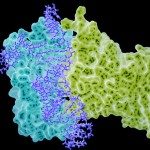Link to Pubmed [PMID] – 18284240
J. Am. Chem. Soc. 2008 Mar;130(11):3579-89
In a wide variety of proteins, insolubility presents a challenge to structural biology, as X-ray crystallography and liquid-state NMR are unsuitable. Indeed, no general approach is available as of today for studying the three-dimensional structures of membrane proteins and protein fibrils. We here demonstrate, at the example of the microcrystalline model protein Crh, how high-resolution 3D structures can be derived from magic-angle spinning solid-state NMR distance restraints for fully labeled protein samples. First, we show that proton-mediated rare-spin correlation spectra, as well as carbon-13 spin diffusion experiments, provide enough short, medium, and long-range structural restraints to obtain high-resolution structures of this 2 x 10.4 kDa dimeric protein. Nevertheless, the large number of 13C/15N spins present in this protein, combined with solid-state NMR line widths of about 0.5-1 ppm, induces substantial ambiguities in resonance assignments, preventing 3D structure determination by using distance restraints uniquely assigned on the basis of their chemical shifts. In the second part, we thus demonstrate that an automated iterative assignment algorithm implemented in a dedicated solid-state NMR version of the program ARIA permits to resolve the majority of ambiguities and to calculate a de novo 3D structure from highly ambiguous solid-state NMR data, using a unique fully labeled protein sample. We present, using distance restraints obtained through the iterative assignment process, as well as dihedral angle restraints predicted from chemical shifts, the 3D structure of the fully labeled Crh dimer refined at a root-mean-square deviation of 1.33 A.



